As an Amazon Associate I earn from qualifying purchases. This website also participates in other affiliate programs and may earn commissions if you shop through the links used on this website.
(This article was originally published on July 13, 2022 and was last updated on July 19, 2022)
If you have only ever grown green sweet basil, it could be time to branch out and discover the many cultivars of purple basil that are now on offer.
If you love basil and want to integrate edibles and ornamental appeal, purple basil could be the perfect addition to your garden.

What is Purple Basil?
As the name suggests, purple basil is a broad name used for basil plants that have purple basil leaves, instead of green leaves.
Like typical sweet basil, purple basil plants make great culinary herbs and can be used wherever Genovese or sweet basil of a green hue might be used.
Purple Basil vs Green Basil Cultivars

Today, purple basil is often referred to as Ocimum basilicum var. purpurascens. This is a catch-all term taken from the varietal from which all the purple-leaved cultivars of basil may descend. All of these cultivars are of the same species as common sweet Basil, though have purple foliage.
Today, there are many different purple basil cultivars to choose from – but all share very similar traits, and can be grown in largely the same ways.
Where Does The Purple Color Come From?
As you may already be aware, it is the substance chlorophyll in most plant leaves that gives them their green color. This is contained within plant cells. Red or purple foliage comes from anthocyanins (pigments that cause red/purple coloration) in the surface cells, rather than the inner cells where chlorophyll is found.
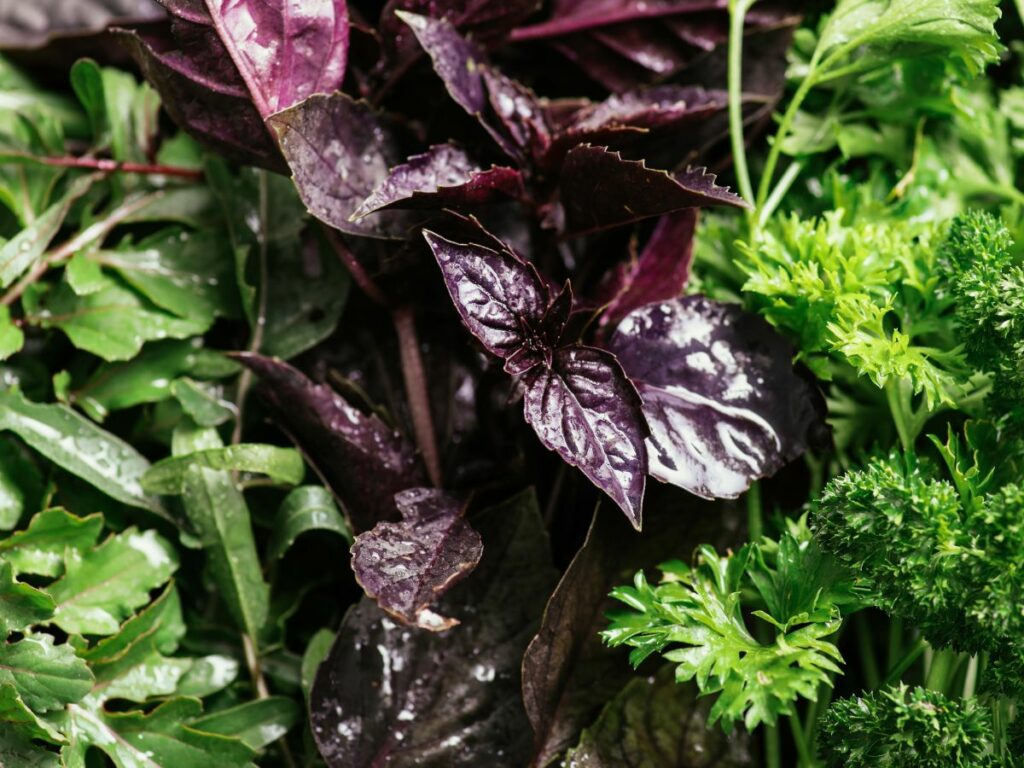
In some cases, the purple outer overlay completely covers the green chlorophyll within. But in other cases, it is only partially obscuring it. Purple pigmentation is hereditary in plants and can be very variable, suggesting that several different genes may be responsible for its presence.
As well as varying due to genetics, the purple can also vary due to environmental factors like sunlight, temperature, and soil composition. Particular purple basil may have very vivid coloration in one location, and be much less vibrant in another.

The purple coloration of the basil does not affect the flavor. But it does make for some highly appealing dishes with rich color. And research suggests that anthocyanins are good for our health in a range of different ways.
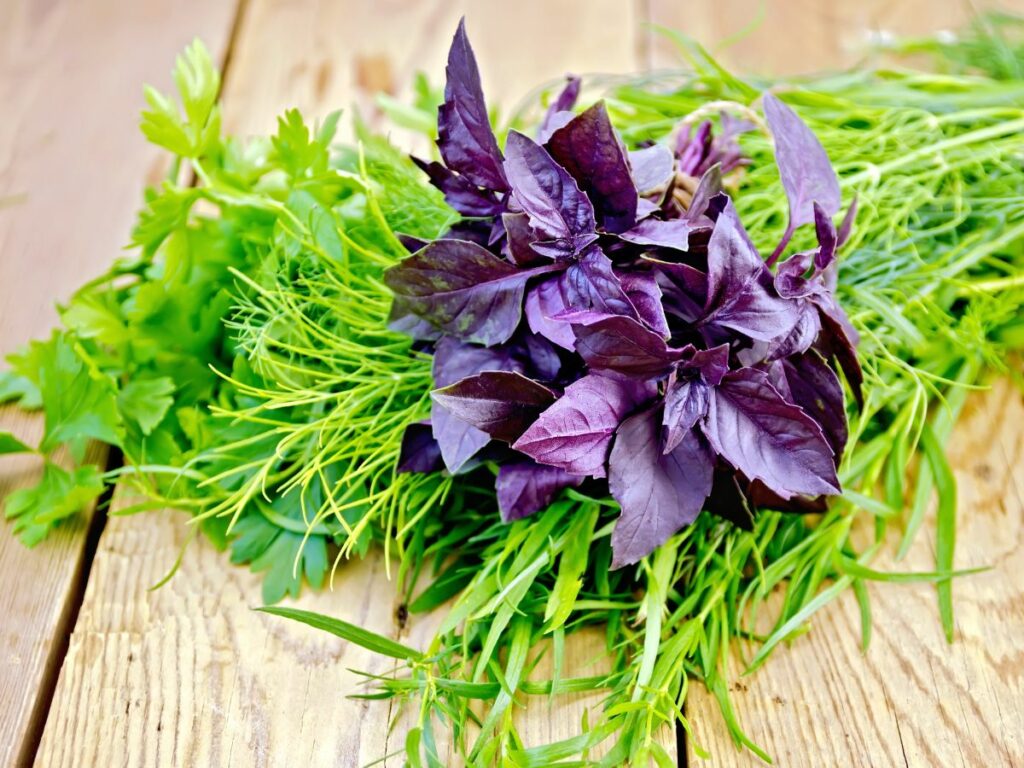
Purple Basil Varieties to Choose
Ocimum basilicum var. purpurascens
Though this name is often used today for any purple basil, originally it referred to a particular cultivar, which was first identified in the 1830s, in England, by George Bentham, a British botanist.
This older strain of purple basil is bushy and grows around 2 ft high. It is characterized by dark purple leaves at the top of the plant, and green leaves towards the lower ends of the stems.
Dark Opal Basil
This gem-like purple basil was developed by John Scarchuk and is one of the best-known purple basils available today. Cooks and culinary experts often praise this cultivar for its flavor, said to be superior to that of many other purple types.
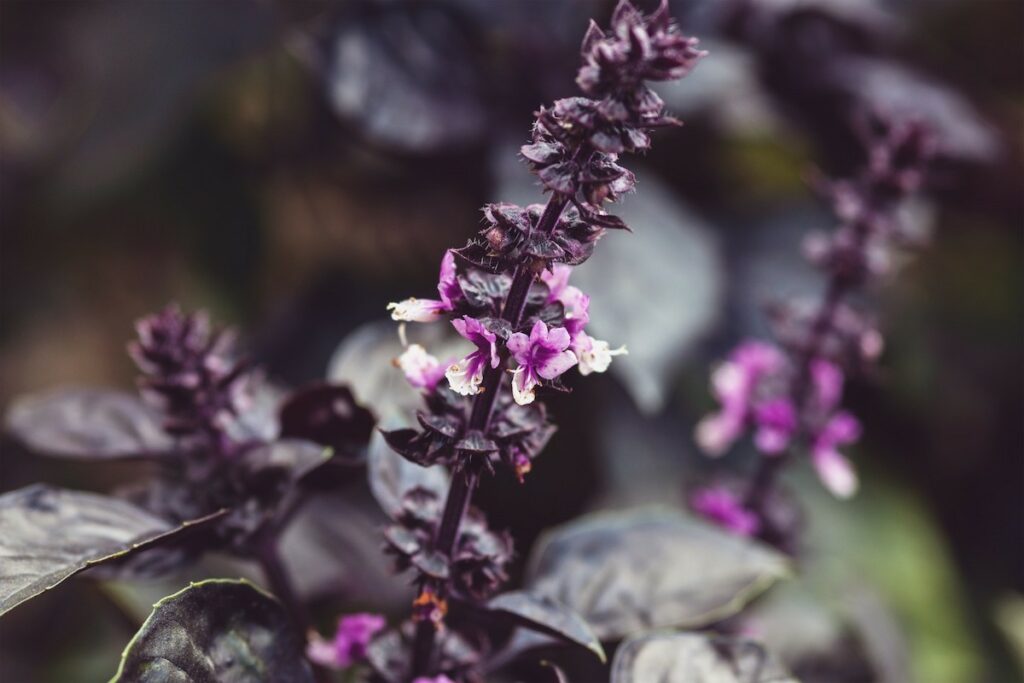
This cultivar originated in a breeding program by the US Department of Agriculture in the mid-1950s. Plant explorers harvested wild basil seeds in Turkey – yes “plant explorers” are a cool part of basil’s history! Scarchuk, just beginning his career at the University of Connecticut, received some of these.
He and his partner, the late Joseph Lent, selected dark purple-leaved basil from the batch that came from these seeds and crossed it with itself until it had more uniformity. Dark Opal was the result and was an All-America Selection winner in 1962.
Red Rubin Basil
Many further cultivars have been developed from this popular strain. One of these is red Rubin, which debuted to North American gardeners and growers in 1993. This was a ‘reselection’ of Dark Opal made by a European firm and was intended to give growers more uniform results from seed.
Purple Ruffles Basil
Purple ruffles is another of the best-known purple basil varieties on the market. It came from a large breeding program for W. Atlee Burpee and Company in the late 1970s by the late Ted Torrey.
Torrey created Purple Ruffles in 1980 by crossing another of his creations, Green Ruffles (a type of lettuce leaf basil), with Dark Opal. It was fixed by 1984 and introduced in 1987.
This is a large, vigorous, and fairly robust basil with large, ruffled leaves, that is just as prized as an ornamental plant as it is as a culinary herb.
Other Purple Basils
There are a couple of Italian cultivars that resemble and may predate purple ruffles – sometimes available to American growers – Genovese Grande Violetto, and Italian Red Basil.
And of course, there are many more named cultivars of purple basil, many derived from one of the above.
Seeds of basil allow a huge amount of diversity to creep in
It is not uncommon, as I know from my own experience, to find purple variations popping up in expected green basil when growing from seed. And purple basils can lose their purple vibrancy over time. The immense variety that can occur in basil can be, at the same time, a blessing and a pain, but it can be very interesting to see what pops up when growing these plants from seed. If you plan on saving your seeds at the end of the growing season, choose seeds from the most vibrant plants, rather than those with less than spectacular coloring.
Vegetative propagation through cuttings can allow us to retain the characteristics, like purple leaves, that we wish to retain.
How to Grow Purple Basil Plants
Purple basil is no more challenging to grow than other Ocimum basilicum cultivars. You can grow it from seed, or cuttings, or purchase young plants to place in your garden. Whichever option you choose, you should find it relatively easy to cultivate your own purple basil at home.
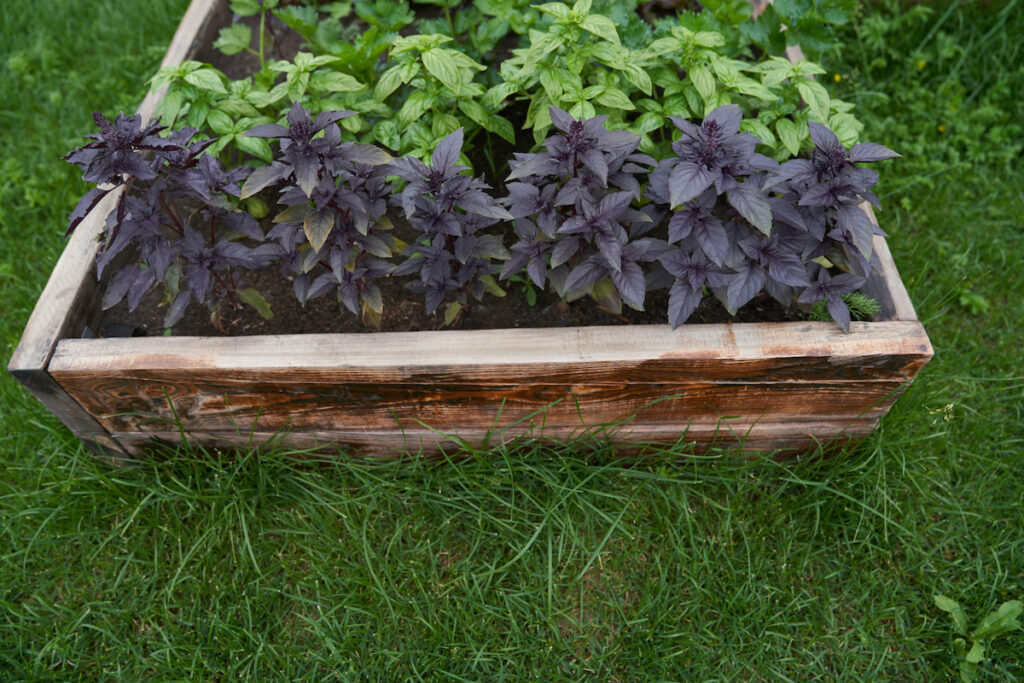
Where to Grow Purple Basil
On the whole, purple basil will grow well wherever any other sweet basil will thrive. These plants like fertile and moist yet free-draining soil.
One additional consideration, however, is that purple basil, often grown for its pigmentation, will often retain better color where there is plenty of light. In more shaded spots, or indoors or under cover in lower light levels, the purple leaf pigmentation will tend to be less intense.
So if you want vibrant purple on the leaves then a position in full sun is best. LED lights with a high proportion of blue light can be helpful to improve purple coloration for indoor-grown plants, but won’t fully replace direct sunlight.
Sowing Purple Basil from Seed
Purple basil seeds in temperate climates are typically sown indoors in spring. They can be grown further indoors, and might be kept as houseplants, but are typically then planted out into a garden once conditions have reliably warmed in late spring or early summer.
Sow seeds around 6mm deep, in seed trays, small pots, or soil blocks. Keep the temperature around 21 degrees C. for optimal germination rates. The seeds should germinate within a week or two if the right conditions have been provided.
Planting Purple Basil
Once the seeds have germinated, and the seedlings have 3-4 sets of leaves, they can be pricked out and potted on into their own individual pots. Always make sure excess water can drain freely from the base of any container you use.
In the garden, prepare your growing area, and space plants accordingly for the cultivar of purple basil that you are growing. (Some grow larger than others.)
Remember that purple basil can be a great companion plant in a vegetable garden or an interesting addition to an edible ornamental garden. Some have found that purple-leaved herbs are less attractive to certain pests than green-leaved varieties, which could come in handy in certain areas.
Caring For Purple Basil
Water your purple basil frequently in dry weather, especially when growing in containers.
But make sure that you do not overwater and do not allow water logging to occur. Water before noon where possible, and try to water the soil below, and not the plant itself, since wet leaves can foster conditions where fungal issues can take hold.
Mulch around your purple basil plants with organic matter for fertility, to conserve moisture, and suppress weed growth.
Basil growing in fertile soil in the ground will not typically need additional fertilizer. But when growing in containers, feeding plants with a nitrogen-rich organic liquid plant feed every couple of weeks through summer can be a good idea.
Purple basil is usually grown as an annual in temperate climes. But if you have purple basil you love, you can grow clones through cuttings so that you will have the plant in your garden again the following year.
Harvesting Purple Basil Leaves

Harvest small quantities of leaves as required as soon as the plants are established. Nipping off the growing tips will make the plants bush out, and so harvesting is pruning too.
Do not allow purple basil to flower if you want the best-tasting leaves. But consider leaving some to flower so that you can gain the ornamental appeal, provide a boon for wildlife, and collect seeds from your plants to experiment with.
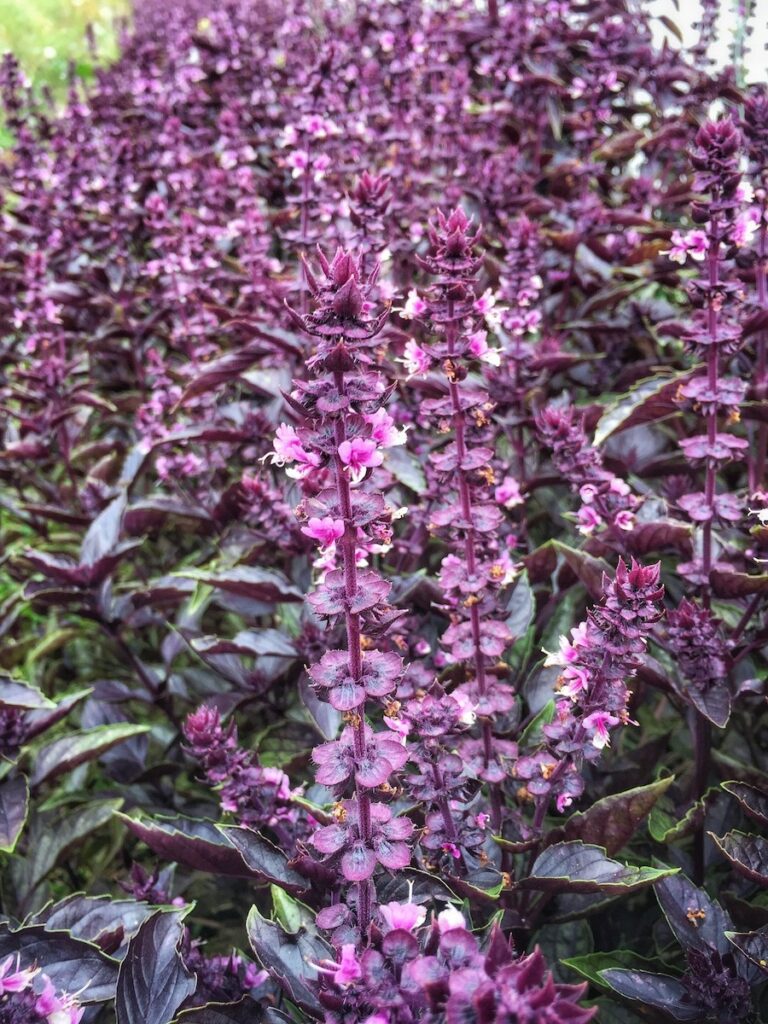
How To Use Purple Basil
Purple basil can be used anywhere you might use typical common basil with green leaves. It can be particularly fun to make a purple pesto, and the leaves look great as a vibrant garnish on a range of dishes.
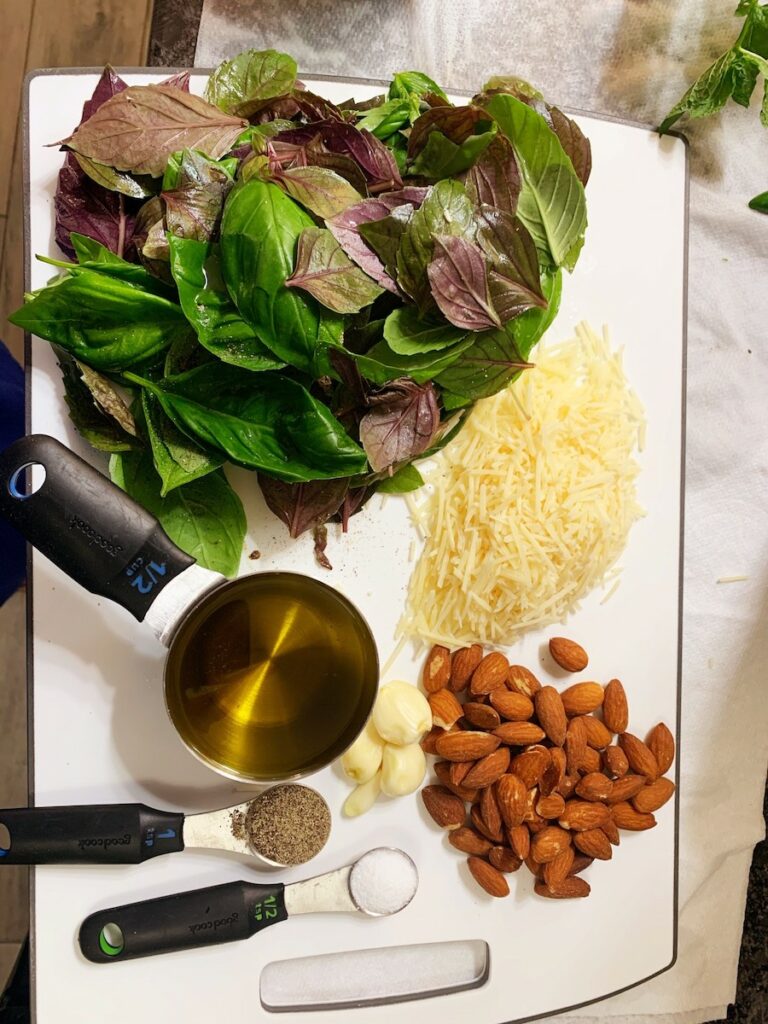
Where to Buy Purple Basil
Some sources of organic purple basil in North America include:
- https://www.johnnyseeds.com/herbs/basil/purple-basil/
- https://www.rareseeds.com/purple-ball-basil/
- https://www.backtonaturecompany.com/products/purple-basil-seeds-organic-non-gmo-heirloom-seeds-herb-seeds-usa-garden-seeds-fresh-2022
Elizabeth is a garden designer, consultancy and writer passionate about growing herbs and other edibles in a sustainable way. She works on her own 1/3 acre garden, growing basil alongside her tomatoes in her polytunnel, and indoors alongside a range of other herbs and crops. She loves inspiring others to get growing and enjoying a home grown diet, wherever they live in the world.

